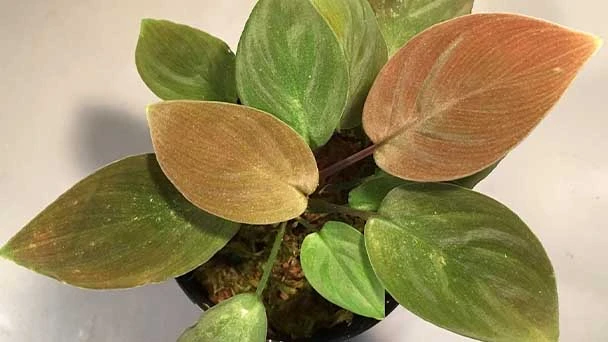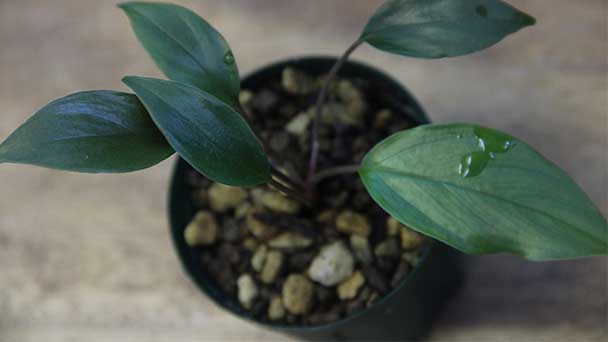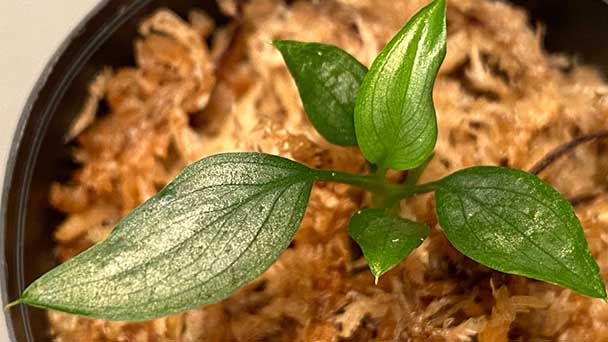Homalomena Plants Care & Propagation Guide
Written by Ivy
Nov 13 2021

Homalomena has a thick and creepy stem with obvious nodes like bamboo. The stem, shoot, petiole and leaf sheath of Homalomena are green, i.e. emerald. Let's see more information about Homalomena!

Scale is small, oval, flat, with waterproof wax protective shell, in brown, black or tan. Scale doesn't move around. It stays where it is and sucks life from plants. Infection can spread rapidly between Homalomena.
Mealybugs are small parasitic insects that look like furry balls. They tend to gather under the leaves of Homalomena and at the connection between the leaves and the stem. They can stack with each other to form a thick intrusion, and their eggs look like small white clouds. They suck the juice of Homalomena and hinder growth.
Except the low temperature season from December to February, it can reproduce in other seasons. It is better to breed from March to April, and can grow fully in the first year, which is conducive to passing the low temperature and drought season in winter and spring. We should choose strong rhizomes and cut them into 3 ~ 4 segments, 10 ~ 12cm long. Seedlings can be raised and transplanted first or directly planted in the field.
When raising seedlings in Homalomena seedbed, the stem segments shall be placed horizontally according to the row spacing of 15 ~ 20cm and the plant spacing of 12cm, and the soil shall be covered for about 3cm. We also need to keep the Homalomena seedbed moist. 1.5 ~ 2 months, rooting and seedling emergence, and planting in the field. Seedling cultivation and planting shall be carried out in a cool and humid period, and shade shall be done in time. Homalomena colonization row spacing 50 cm × 40 cm. One root seedling or 1 ~ 2 segments of rhizome shall be planted in each hole.
From March to May every year, we can select the robust rhizome of Homalomena, cut it into 15 cm long cuttings with 3-4 nodes, open 8-10 cm shallow ditches on the border surface of the seedling land according to the row spacing of 20 cm, and place one cuttings obliquely on the seedling bed every 10-12 cm in the ditch, covered with soil and compacted. We should pay attention to exposing 1 / 3 of the Homalomena cuttings when covering the soil, and then cover the seedbed with a layer of straw. The seedbed shall be watered frequently to keep the soil moist and facilitate the growth of new seedlings. After 2-3 months, the cuttings of Homalomena grow several roots, which can be transplanted when the seedling is 10 cm high. Layering seedling raising: select strong creeping rhizomes in situ, cover a small pile of soil on the rhizomes every 15 cm, and cut them with a knife for seedling transplantation after the pressed rhizomes grow new seedlings.
Homalomena can be placed in the living room, which can play the role of Feng Shui in helping to boost popularity and circulate wealth. However, it should be noted that Homalomena likes warm, humid and semi shady environment. It grows vigorously in summer, so it needs to be placed in the shade to avoid strong light. Otherwise, it is easy to cause dry sharp edges of leaves and affect the viewing effect. Therefore, after leaving the room in early spring, it should be placed under the shady scaffold or eaves or the shade of the balcony. In winter, Homalomena needs to be moved indoors for winter, placed in a place with sufficient strong light and good ventilation, and the temperature is kept at 6-18 ℃. If the room temperature is too high, it is easy to cause excessive leaf growth and consume a lot of nutrients, resulting in weak growth the next year and affecting normal flowering and fruiting.
From the perspective of Feng Shui, breeding Homalomena can make people healthy, energetic, far away from diseases and disasters, make families happy and auspicious, and husband and wife love and harmony. To make good use of the Feng Shui function of Homalomena, you should pay attention to putting Homalomena in the bedroom, which will help the owner establish a feng shui home and facilitate the development of husband and wife's feelings. Homalomena can remove nicotine, formaldehyde and other harmful substances. Breeding Homalomena will create a perfect living space for the living environment. And its shape is huge, its branches and leaves are green, and its fruit is bright red.
Homalomena Quick InfoHomalomena Care in DetailHomalomena WateringHomalomena Soil CareHomalomena Light RequirementsHomalomena Temperature CareHomalomena Humidity CareHomalomena FertilizerHomalomena PruningHomalomena RepottingHomalomena Pest & Disease ControlHomalomena PropagationHomalomena Propagation from CuttingHomalomena Propagation from DivisionHomalomena VarietiesEmerald GemPurple SwordHomalomena Benefits
Homalomena Quick Info
| Botanical/Scientific Name | Homalomena |
| Common Name | Silver Shield |
| Varieties | Emerald Gem,Purple Sword,Selby |
| Uses | Local medicinal uses |
| Origin | Southern Asia and the southwestern Pacific |
| Light Care | Bright indirect light |
| Soil Care | 50% of the soil |
| Temperature Care | Between 65-85 degrees |
| Humidity Care | Average household humidity |
| Watering | Regular watering schedule |
| Pruning Care | Sanitary pruning |
| Fertilizer Care | A general houseplant fertilizer diluted to half the recommended strength |
| Propagation | Dividing the bush |
| Toxic | Toxic to animals and humans |
Homalomena Care in Detail

Homalomena Watering
Homalomena is humid, closed and afraid of cold, drought and strong light. It is a typical shade loving plant. Generally, the annual average temperature is about 22 ℃, the annual rainfall is more than 1000mm, the air relative humidity is more than 80%, and the canopy density is 70% - 90%. homalomena grows well on fertile sandy soil with water content of 30% ~ 40%. It can withstand short-time low temperature of about 0 ℃. Too dry, the plant is easy to wither and die. Under strong light, Homalomena grows slowly, its leaves turn yellow and even burn.Homalomena Soil Care
The soil moisture content grows well on 30% ~ 40% fertile sandy soil. Homalomena can withstand short-term low temperature of about 0 ℃. Too dry, Homalomena is easy to wither and die. Under strong light, plants grow slowly, their leaves turn yellow and even burn.Homalomena Light Requirements
Although Homalomena can withstand low light conditions, your Homalomena will perform best under medium indirect light conditions. The sign that your Homalomena camouflage gets too much light is burning leaves. This can be solved by changing the position of homalomen to a position more suitable for its lighting requirements.Homalomena Temperature Care
Homalomena likes to be warm, moist and closed, and is afraid of cold, drought and strong light. It is a typical shade loving plant. Generally, the annual average temperature is about 22 ℃, the annual rainfall is more than 1000mm, the air relative humidity is more than 80%, and the canopy density is 70% - 90%.Homalomena Humidity Care
In order for Homalomena to develop and grow within the normal range and have a spectacular appearance, it needs to increase air humidity. To do this, we often use the sprayer to wet the Homalomena, or put any wet material (expanded clay, pebble) into the deep tray, and place a pot at the top. You can also use a household humidifier to maintain the air humidity of Homalomena. Moisten shrubs at least once in two or three days. In winter and keep cool, Homalomena will not be moist by spray bottle.Homalomena Fertilizer
In the field management of Homalomena, we should frequently weed and loosen the soil at the seedling stage, and apply nitrogen fertilizer to promote seedling growth. In late spring, early summer and early rainy season, calendering or ditching shall be carried out every year to apply stable manure and turf mud, and soil cultivation shall be carried out in combination with Homalomena fertilization, which is conducive to stem growth and warm overwintering. The soil is easy to dry. Cover grass to moisturize before winter. If the soil is dry in dry season, it must be irrigated. We also need to keep Homalomena shaded at all times to prevent direct sunlight.Homalomena Pruning
We'd better not over prune the roots of Homalomena. You can trim the roots of Homalomena, but it will shake Homalomena. I've never trimmed leaves and roots, but I know that caves sometimes melt into something with almost nothing but roots, and then come back. So you don't put too much pressure on Homalomena.Homalomena Repotting
These plants grow best when their roots are slightly tight, so they don't need to be particularly careful and report regularly. The ideal time for Homalomena repotting is early spring, when plants grow actively and begin to grow after hibernation. The roots hover at the bottom of the nursery. I can just increase the tank size of homalmena repotting several times without any other huge changes.Homalomena Pest & Disease Control
Spider mites are very small and almost invisible. They also draw sap from Homalomena, preferring the edges of plants with soft leaves, such as Homer and aloe. Serious pests usually leave obvious "cobwebs" on the leaves, which are rotated by the mites themselves. Homalomena leaves attacked by spider mites turn yellow, change color and fall off.Scale is small, oval, flat, with waterproof wax protective shell, in brown, black or tan. Scale doesn't move around. It stays where it is and sucks life from plants. Infection can spread rapidly between Homalomena.
Mealybugs are small parasitic insects that look like furry balls. They tend to gather under the leaves of Homalomena and at the connection between the leaves and the stem. They can stack with each other to form a thick intrusion, and their eggs look like small white clouds. They suck the juice of Homalomena and hinder growth.
Homalomena Propagation

Homalomena Propagation from Cutting
We can use Homalomena cutting propagation. Homalomena grows slowly. During the growth period, with the increase of stems on the ground, rhizomes also grow and thicken, and new buds are continuously extracted from rhizome nodes to grow new ramets and form plant clusters. Homalomena can sprout to form new ramets all year round. There are more sprouting plants in vegetative growth period and less in flowering period.Except the low temperature season from December to February, it can reproduce in other seasons. It is better to breed from March to April, and can grow fully in the first year, which is conducive to passing the low temperature and drought season in winter and spring. We should choose strong rhizomes and cut them into 3 ~ 4 segments, 10 ~ 12cm long. Seedlings can be raised and transplanted first or directly planted in the field.
When raising seedlings in Homalomena seedbed, the stem segments shall be placed horizontally according to the row spacing of 15 ~ 20cm and the plant spacing of 12cm, and the soil shall be covered for about 3cm. We also need to keep the Homalomena seedbed moist. 1.5 ~ 2 months, rooting and seedling emergence, and planting in the field. Seedling cultivation and planting shall be carried out in a cool and humid period, and shade shall be done in time. Homalomena colonization row spacing 50 cm × 40 cm. One root seedling or 1 ~ 2 segments of rhizome shall be planted in each hole.
From March to May every year, we can select the robust rhizome of Homalomena, cut it into 15 cm long cuttings with 3-4 nodes, open 8-10 cm shallow ditches on the border surface of the seedling land according to the row spacing of 20 cm, and place one cuttings obliquely on the seedling bed every 10-12 cm in the ditch, covered with soil and compacted. We should pay attention to exposing 1 / 3 of the Homalomena cuttings when covering the soil, and then cover the seedbed with a layer of straw. The seedbed shall be watered frequently to keep the soil moist and facilitate the growth of new seedlings. After 2-3 months, the cuttings of Homalomena grow several roots, which can be transplanted when the seedling is 10 cm high. Layering seedling raising: select strong creeping rhizomes in situ, cover a small pile of soil on the rhizomes every 15 cm, and cut them with a knife for seedling transplantation after the pressed rhizomes grow new seedlings.
Homalomena Propagation from Division
Both the seedling raising and planting sites of Homalomena should choose broad-leaved forests with lush trees, loose and fertile slopes, river valleys or shady wetlands by streams. The slope with terrain no more than 30 degrees should be selected for understory cultivation, and the loose sandy soil should be selected for mountain cultivation of Homalomena. Avoid cultivating in dry, low-lying, sticky and barren soil. For the cultivation under the forest of Homalomena, the land shall be prepared at the end of winter and the beginning of spring to remove the sundries under the forest and maintain the canopy density of 70% ~ 90%. For the cultivation in mountainous areas, the land shall be turned over first, generally 25 ~ 30cm deep, and made into a high or flat border. The border width and height can be adjusted according to the local conditions.Homalomena Varieties
Emerald Gem
The flowering period of this homaomena variety is autumn, and the flowers are solitary to the upper leaf axil, which is composed of Buddha flame bud and white meat spike inflorescence. This Homalomena variety has large flowers, long and pointed, like sharp pepper, 15-20cm long and 12-15cm long petiole. When the flowers bloom, they are green outside and red or white inside, with strong tea flavor, refreshing, brain clearing and eyesight. This Homalomena variety has a stamen style, halo milky white or white, thick middle finger, like a corn cob.Purple Sword
This Homalomena variety likes a humid environment. It should be watered immediately after planting, twice on the third day, and three on the sixth day. After the three, it should be watered according to the weather conditions, so as to keep the soil moist without ponding. In summer, we need to water the This Homalomena variety in time, spray the leaves and drain the water in time to prevent the water from getting rotten. After autumn, if the temperature is not high, watering should be controlled to prevent autumn hair. Pour enough antifreeze water before winter. The reclaimed water shall be poured at the beginning of March of the next year. Except that whether to water depends on the precipitation in July and August, it shall be poured once from April to October, and anti freezing water shall be poured before winter. In the third year, the same method was used to irrigate this Homalomena variety, and in the fourth year, it was under normal management, but the antifreeze water and rejuvenation water should be fully watered.Homalomena Benefits
Homalomena can be used as root medicine to treat traumatic injury, fracture, traumatic bleeding, numbness of four branches, muscle and pulse contracture, rheumatic low back and leg pain, rheumatoid arthritis, stomach pain, gastroenteritis, Sha syndrome, etc.Homalomena can be placed in the living room, which can play the role of Feng Shui in helping to boost popularity and circulate wealth. However, it should be noted that Homalomena likes warm, humid and semi shady environment. It grows vigorously in summer, so it needs to be placed in the shade to avoid strong light. Otherwise, it is easy to cause dry sharp edges of leaves and affect the viewing effect. Therefore, after leaving the room in early spring, it should be placed under the shady scaffold or eaves or the shade of the balcony. In winter, Homalomena needs to be moved indoors for winter, placed in a place with sufficient strong light and good ventilation, and the temperature is kept at 6-18 ℃. If the room temperature is too high, it is easy to cause excessive leaf growth and consume a lot of nutrients, resulting in weak growth the next year and affecting normal flowering and fruiting.
From the perspective of Feng Shui, breeding Homalomena can make people healthy, energetic, far away from diseases and disasters, make families happy and auspicious, and husband and wife love and harmony. To make good use of the Feng Shui function of Homalomena, you should pay attention to putting Homalomena in the bedroom, which will help the owner establish a feng shui home and facilitate the development of husband and wife's feelings. Homalomena can remove nicotine, formaldehyde and other harmful substances. Breeding Homalomena will create a perfect living space for the living environment. And its shape is huge, its branches and leaves are green, and its fruit is bright red.
Latest Updated
- Benefits of Bugleweed - 7 Science-backed Health Benefits
- Bugleweed Dangers & Side Effects - Is It Poisonous?
- How to Plant Evergreen Trees - What You Should Know
- When to Plant Evergreens - Grow Guide for Evergreen Trees
- 12 Wonderful Evergreen Shrubs for Your Garden
- 12 Popular Evergreen Plants with Pictures for Beginners
- When And How To Prune A Lilac Bush Like a Pro
- How to Grow & Care for Lilac Vine (Hardenbergia Violacea)
- Japanese Lilac Tree (Syringa Reticulata) Care & Propagation Guide
- Shumard Oak Pros and Cons - What to Know
Popular Articles
- Winter maintenance of Antirrhinum Majus
- How to Grow Terminalia Mantaly Tree
- How to Grow and Care for Crossostephium Chinense
- How to grow Antirrhinum Majus in spring
- Peristeria Elata (Dove Orchid) Profile: Info & Care Guide
- Underwatered Snake Plant (Sansevieria Trifasciata) - Signs And How To Fix
- How to Care for Brazilian Jasmine Plant (Mandevilla Sanderi)
- How to Grow & Care for Graptopetalum Purple Delight in Summer
- Rosa Chinensis (China Rose): Plant Growing & Care Tips
- How to Care for Baby Sun Rose (Aptenia Cordifolia)